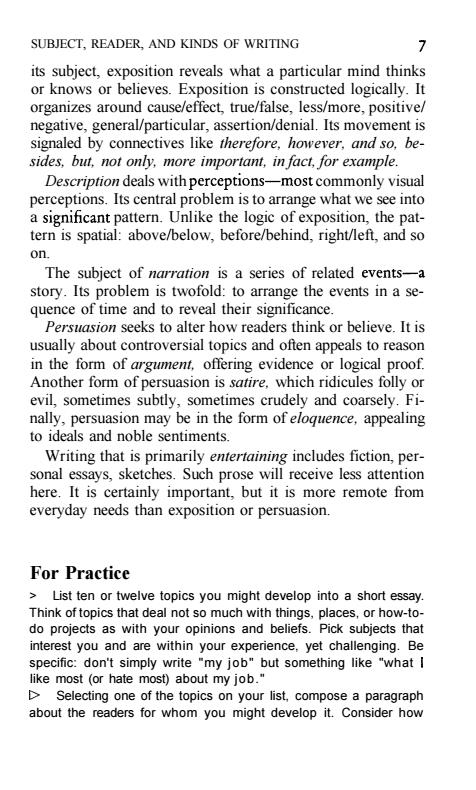正在加载图片...

SUBJECT,READER,AND KINDS OF WRITING 7 its subject,exposition reveals what a particular mind thinks or knows or believes.Exposition is constructed logically.It organizes around cause/effect,true/false,less/more,positive/ negative,general/particular,assertion/denial.Its movement is signaled by connectives like therefore,however,and so,be- sides,but,not only,more important,in fact,for example. Description deals with perceptions-most commonly visual perceptions.Its central problem is to arrange what we see into a significant pattern.Unlike the logic of exposition,the pat- tern is spatial:above/below,before/behind,right/left,and so on. The subject of narration is a series of related events-a story.Its problem is twofold:to arrange the events in a se- quence of time and to reveal their significance. Persuasion seeks to alter how readers think or believe.It is usually about controversial topics and often appeals to reason in the form of argument,offering evidence or logical proof. Another form of persuasion is satire,which ridicules folly or evil,sometimes subtly,sometimes crudely and coarsely.Fi- nally,persuasion may be in the form of eloquence,appealing to ideals and noble sentiments. Writing that is primarily entertaining includes fiction,per- sonal essays,sketches.Such prose will receive less attention here.It is certainly important,but it is more remote from everyday needs than exposition or persuasion. For Practice List ten or twelve topics you might develop into a short essay. Think of topics that deal not so much with things,places,or how-to- do projects as with your opinions and beliefs.Pick subjects that interest you and are within your experience,yet challenging.Be specific:don't simply write "my job"but something like "what I like most (or hate most)about my job." Selecting one of the topics on your list,compose a paragraph about the readers for whom you might develop it.Consider howSUBJECT, READER, AND KINDS OF WRITING 7 its subject, exposition reveals what a particular mind thinks or knows or believes. Exposition is constructed logically. It organizes around cause/effect, true/false, less/more, positive/ negative, general/particular, assertion/denial. Its movement is signaled by connectives like therefore, however, and so, besides, but, not only, more important, in fact, for example. Description deals with perceptions—most commonly visual perceptions. Its central problem is to arrange what we see into a significant pattern. Unlike the logic of exposition, the pattern is spatial: above/below, before/behind, right/left, and so on. The subject of narration is a series of related events—a story. Its problem is twofold: to arrange the events in a sequence of time and to reveal their significance. Persuasion seeks to alter how readers think or believe. It is usually about controversial topics and often appeals to reason in the form of argument, offering evidence or logical proof. Another form of persuasion is satire, which ridicules folly or evil, sometimes subtly, sometimes crudely and coarsely. Finally, persuasion may be in the form of eloquence, appealing to ideals and noble sentiments. Writing that is primarily entertaining includes fiction, personal essays, sketches. Such prose will receive less attention here. It is certainly important, but it is more remote from everyday needs than exposition or persuasion. For Practice > List ten or twelve topics you might develop into a short essay. Think of topics that deal not so much with things, places, or how-todo projects as with your opinions and beliefs. Pick subjects that interest you and are within your experience, yet challenging. Be specific: don't simply write "my job" but something like "what I like most (or hate most) about my job." £> Selecting one of the topics on your list, compose a paragraph about the readers for whom you might develop it. Consider how